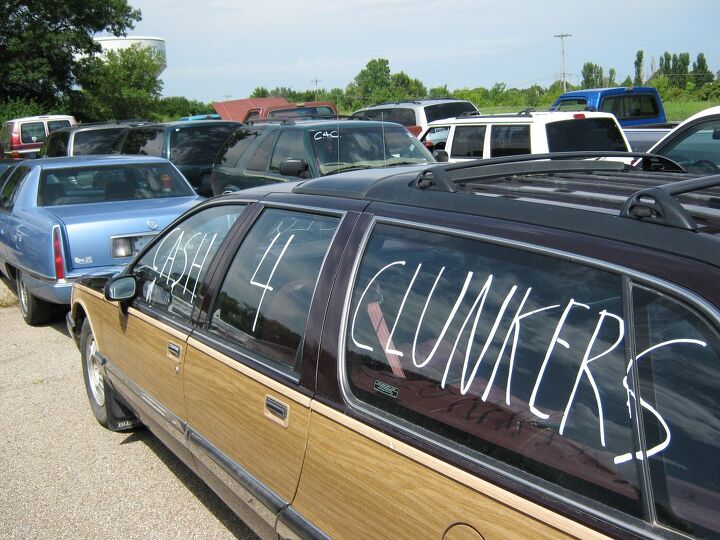White House To Edmunds: Don't Knock Cash For Clunkers
It is unfortunate that Edmunds.com has had nothing but negative things to say about a wildly successful program that sold nearly 250,000 cars in its first four days alone. There can be no doubt that CARS drummed up more business for car dealers at a time when they needed help the most.
The Department of Transportation’s Bill Adams lays into recent Edmunds.com analysis showing Cash For Clunkers could have cost as much as $24,000 per vehicle sale [via CNN]. But one man’s negativity is another man’s constructive criticism. After all, Adams doesn’t touch the heart of the matter: the program’s cost per vehicle, and Edmund’s analysis (like all analysis) was educated guesswork. Luckily, CNN was able to shed a little more light on how Edmunds came up with their numbers.
In order to determine whether these sales would have happened anyway, Edmunds.com analysts looked at sales of luxury cars and other vehicles not included under the Clunkers program.
Using traditional relationships between sales volumes of those vehicles and the types of vehicles sold under Cash for Clunkers, Edmunds.com projected what sales would normally have been during the Cash for Clunkers period and in the weeks after.
And guess what? Ford analyst George Pipas basically concurs with Edmund’s calculation of incremental sales, and therefore the cost of the program. But he still echoes the DOT’s line: C4C was a success… as long as you ignore the amount of money spent.
The whole purpose of the program was to provide some kind of catalyst to kick-start the economy, and by all accounts the extra production that was added this year was a boost to the economy.
Indeed it was. The White House says that up to 1.6 of the 3.5 percent increase in 3rd quarter GDP came from a cash-for-clunker-stimulated auto sector. Which explains why they’re lambasting the Edmunds report: like Ford, they have a vested interest in seeing Cash For Clunkers hailed as a success, and possibly even repeated. But that requires glossing over the fact that incremental stimulus estimates range from 30 to 60 percent of clunker sales, meaning that even by the most optimistic analysis, C4C was an expensive endeavor when measured on a per-incremental-sale basis. And, as Edmund‘s points out in their retort to the White House’s retort:
It is also claimed we missed the possibility that Cash for Clunkers generated excitement and consumers bought vehicles even if they didn’t qualify for the program — a claim that has been widely supported by anecdote but by little analysis. It does, after all, seem a bit odd that masses of consumers would elect to buy a vehicle because of a program for which they don’t qualify — doubly so when you add in the fact that prices shot up during Cash for Clunkers, creating a disincentive to buy.
September’s miserable sales showing by GM and Chrysler (the two automakers the US government most needs to be stimulated) shows that the stimulus had a hangover effect on demand (despite a possible flattening-out caused by the anti-stimulation of non-qualifying segments illustrated above), and (more importantly) a confusing effect on inventory and production strategy. The fact that C4C increased 4Q auto production may have been good for GDP numbers, but it actually makes another collapse of the taxpayer-owned automakers more likely if unstimulated demand doesn’t catch up. Finding a real, sustainable bottom of the market from which to grow is not made easier by erratic bursts of stimulus frenzy. But then, if the cost per incremental sale of C4C doesn’t matter, why would another injection of cash into the reeling zombie automakers matter?
More by Edward Niedermeyer
Latest Car Reviews
Read moreLatest Product Reviews
Read moreRecent Comments
- Lou_BC Well, I'd be impressed if this was in a ZR2. LOL
- Lou_BC This is my shocked face 😲 Hope formatting doesn't fook this up LOL
- Lou_BC Junior? Would that be a Beta Romeo?
- Lou_BC Gotta fix that formatting problem. What a pile of bullsh!t. Are longer posts costing TTAC money? FOOK
- Lou_BC 1.Honda: 6,334,825 vehicles potentially affected2.Ford: 6,152,6143.Kia America: 3,110,4474.Chrysler: 2,732,3985.General Motors: 2,021,0336.Nissan North America: 1,804,4437.Mercedes-Benz USA: 478,1738.Volkswagen Group of America: 453,7639.BMW of North America: 340,24910.Daimler Trucks North America: 261,959


































Comments
Join the conversation
Christina Romer, chair of the President's Council of Economic Advisers, is one of the foremost experts on stimulus and multipliers. (Her research is more ambiguous than her public statements, as politics force people to sound more certain than the conventions of academic research require.) Yet Pch101 has the temerity to contradict her about how to judge C4C and then claim that others don't understand Economics 101! Everyone agrees about the correct way to measure the impact of C4C. Small differences in assumptions lead to different results. The program is unprecedented in US history, and the only analogies are admittedly imperfect. I would prefer that the Edmunds's analysis be made public, but it's absurd to use only Q3 GDP data to judge the program, and it's absurd to think that a preliminary report issued September 10 is the final word, when we still await to see if actuals from Q4 match the projections in that report. The CEA report agrees, as the CEA notes within that they expect to update the report as more data comes in. It's simply not worth jumping up and down prematurely on something that is so difficult to judge right now.